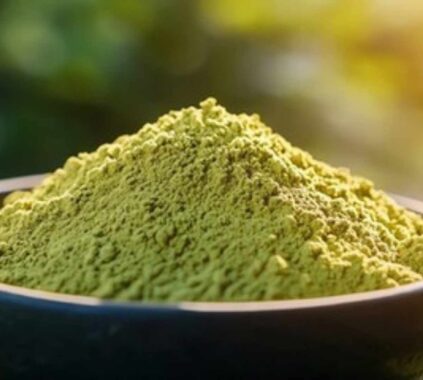Kratom is available in various forms, including capsules and powders. One of the most enjoyable and traditional ways to consume it is by brewing it into tea. The information about making kratom tea will be provided here for anyone who wants to learn.
This article will demonstrate the proper brewing techniques while providing expert suggestions on preparing the best kratom tea recipe, alongside discussing what makes tea the top choice among kratom enthusiasts.
The knowledge of preparing kratom tea will increase your enjoyment and offer you a soothing drink with customizable flavors for this botanical.
This blog explains the process of preparing kratom tea, as well as kratom powder and kratom drinks, to achieve premium consumption.
Why Choose Kratom Tea?
People choose kratom tea because of its various attractive features. People enjoy kratom tea because it provides a flexible method to absorb this botanical substance.
The tea provides you with ample opportunity to personalize it through different flavor options, sweeteners, and additional ingredients according to your taste.
The process of brewing kratom into tea acts to minimize its bitter aftertaste, which enhances its taste for people who use the product.
Its character as kratom tea enables effortless digestion. People tend to find that kratom tea provides a better stomach reaction than kratom powder consumption. Drinking tea also leads to a soothing ritual that requires preparation and consumption.
Why Tea is One of Our Favorite Ways to Enjoy Kratom
Brewing tea is one of the best ways to take kratom, offering a blend of traditional and modern wellness benefits.
- Convenience: You can easily prepare and drink kratom tea since its preparation process is both simple and convenient which enables routine incorporation.
- Gentle Onset: When consumed as tea Kratom produces its effects over time gradually providing users with a more comfortable experience than alternative kratom-based products.
- Taste and Aroma: Kratom tea that includes various loose-leaf herbs serves to reduce the bitter taste of kratom powder for an improved consumption experience. The addition of honey or lemon to kratom tea produces a comforting drinking experience.
- Customizable Serving: People who drink kratom tea gain complete control of the serving strength because it enables users to determine their perfect level of consumption.
What You’ll Need to Make Kratom Tea
Before we get into the steps, let’s gather the essentials for making kratom tea:
- Kratom Powder: To create excellent kratom tea one must utilize outstanding kratom powder as its essential ingredient. To achieve specific goals choose between the strain Red Bali for relaxation or White Maeng Da for energy.
- Water: Use filtered water for the best taste.
- Heat Source: A stove or electric kettle will work.
- Tea Strainer or Cheesecloth: To filter out the kratom powder after brewing.
- Optional Add-Ins: Lemon juice, honey, sugar, or other flavorings to enhance the taste.
Step-by-Step Guide: How to Make Kratom Tea
Now that you have your ingredients and tools ready, let’s walk through the process of making kratom tea.
Step 1: Measure Your Kratom Powder
The first step requires measuring the appropriate amount of kratom powder according to your needs.
Different individuals prefer different serving sizes ranging from 2 to 4 grams although personal tolerance plays a role. A digital scale should be used to achieve precise measurements.
Step 2: Boil the Water
Boil two to three cups of water at a low temperature. Strong boiling heat should be prevented because intense temperatures may degrade kratom alkaloids, thus making the substance less potent.
Step 3: Add Kratom Powder
After the water begins boilin,g you should decrease the heat intensity to a simmer level, then add the kratom powder. Gently mix the liquid until all the kratom powder becomes evenly spread throughout.
Step 4: Simmer and Steep
The mixture needs to be cooked at low heat for 15 to 20 minutes. During this period, the kratom powder releases its alkaloids into the water. A prolonged simmer time of up to thirty minutes will create stronger kratom tea.
Step 5: Add Lemon Juice (Optional)
A single dropper of an acidified mixture such as lemon juice increases the number of alkaloids extracted from kratom powder to achieve stronger tea effects.
Although optional, this step will produce a stronger final product.
Step 6: Strain the Tea
The heated tea needs a few minutes to achieve an ambient temperature before you can proceed.
A tea strainer or cheesecloth provides an effective way to obtain smooth drinkable tea by filtering out the kratom powder.
Step 7: Sweeten and Flavor (Optional)
The tea requires either honey or sugar or additional flavoring options for a better taste. Kratom tea possesses a bitter taste which makes this step beneficial for users who dislike its natural taste.
Step 8: Enjoy Your Kratom Tea
Drink your freshly prepared kratom tea in a cup as soon as it cools down. Liberally and with care consume your tea throughout the experience.
Tips for Making the Best Kratom Tea
To ensure your kratom tea turns out perfectly every time, here are some expert tips:
1. Use High-Quality Kratom Powder
The quality of your kratom powder determines the ultimate quality of your tea. Professional and trusted vendors who perform quality tests on their pure kratom powder can deliver optimal outcomes.
2. Avoid Boiling Water Too Vigorously
High heat causes kratom alkaloids to break down thus maintaining water temperature at a simmer level instead of boiling.
3. Experiment with Flavors
Kratom tea contains a bitter taste which natural sweeteners including honey and stevia effectively conceal. Mint and ginger herbs, when added help to improve the taste of your tea.
4. Adjust the Strength
A strong tea can be adjusted through water addition. To make stronger tea bump up either your kratom powder dose or let the mixture cook for more time.
5. Store Leftovers Properly
A properly prepared kratom tea mixture can remain good in the refrigerator for between two and three days.
Stove or cold temperature serves as the appropriate heating method for this tea.
Creative Kratom Tea Recipes
If you’re feeling adventurous, try these creative kratom tea recipes to mix things up:
1. Citrus Kratom Tea
- Placing lemon or orange slices in along with the mix during simmering will give your beverage a crisp citrus essence.
- Use honey for sweetening to achieve proper taste balance.
2. Spiced Kratom Tea
- Cinnamon sticks along with cloves and ginger added during simmering will give the drink a warming spicy taste.
- It works perfectly as a cold beverage or an evening drink.
3. Iced Kratom Tea
- Prepare kratom tea as normal before it cools then transfer the mixture over frozen ice cubes.
- A drop of fruit juice transforms the hot liquid into a delightful summer beverage.
Best Practices When Making Kratom Tea
Is Hot Water Better Than Boiling Water?
Numerous sources indicate that boiling kratom beverages harms alkaloid content but research indicates this misconception is incorrect.
Our study demonstrates that kratom alkaloids retain stability when the temperature is higher than boiling water.
We performed tests on kratom tea to see how much mitragynine was present in the tea liquid after it cooled from boiling temperatures.
Our results show that hot water tea extractions are very effective and the mitragynine survived the high temperatures. 60-70% of the alkaloids from the raw kratom powder were transferred from the leaf to the water.
However, kratom has many different alkaloids and not all of them possibly do as well as mitragynine does.
Some consumer feedback suggests that kratom tea offers a different experience than kratom powder mixed with water at non-boiling temperatures.
Adding an Acid to Prevent Compound Degradation
The alkaloids present in kratom exhibit sensitivity towards breakdown during specific environmental conditions.
A slight addition of acidic juice extracted from lemons or limes will guard kratom alkaloids against degradation when brewing tea.
Acidic substances maintain alkaloids intact as they stabilize these compounds during the brewing process. The effect of lemon together with citrus products works as an effective potentiator.
Sweetening
The bitter taste of Kratom tea can be softened using sweeteners like honey or sugar along with other acceptable sweeteners that do not affect the active compounds.
Stirring and Straining
The mixture requires regular stirring during boiling to achieve proper dispersion of powder that assists alkaloid extraction.
A simple strain of the tea through a fine sieve minimizes the appearance of particles while delivering a better drinking experience.
The Importance of Serving Size
When preparing kratom tea you should watch the measurements carefully to control the effects which depend on how much kratom is used.
Begin by using a smaller measure because you can always add more but not decrease the amount.
Modify subsequent servings depending on how your body reacts and the effect you want to achieve.
Super Speciosa recommends adding either one tea sachet or four to five grams of powder crushed from the leaf. The recommended multiple for making kratom powder tea into one serving is 2.4 grams.
Why Kratom Tea is a Popular Choice
Drinking kratom tea represents a method of using kratom and an entire sensory experience. Drinking tea involves a relaxation-inducing process that creates the perfect restful activity after work.
Users can adjust both the flavors and strength of their tea and make it align with their tastes.
Users who struggle with consuming kratom powder will find kratom tea an attractive alternative because it delivers a better taste.
The utilization of kratom tea as a consumption method provides gentler effects on digestive health for particular users.
Final Thoughts
Making kratom tea at home turns out to be a basic yet fulfilling method that enables users to experience kratom through drinkable and personalized doses.
You can brew successful kratom tea that meets your requirements after following the techniques described in this guide.
The versatility of kratom tea allows people to enjoy its possible benefits through either hot spiced preparations during cold nights or cold iced versions during sunny days.







